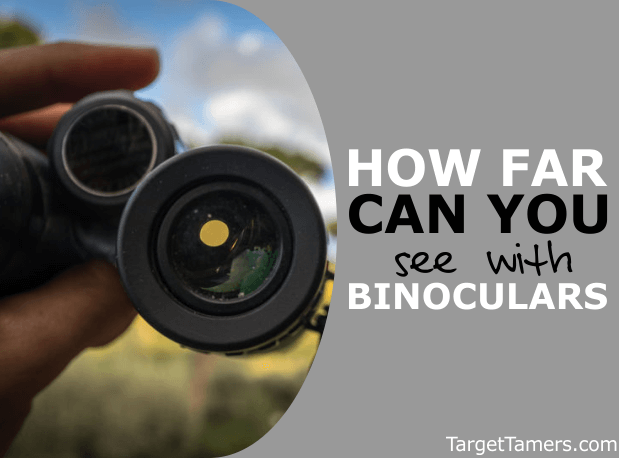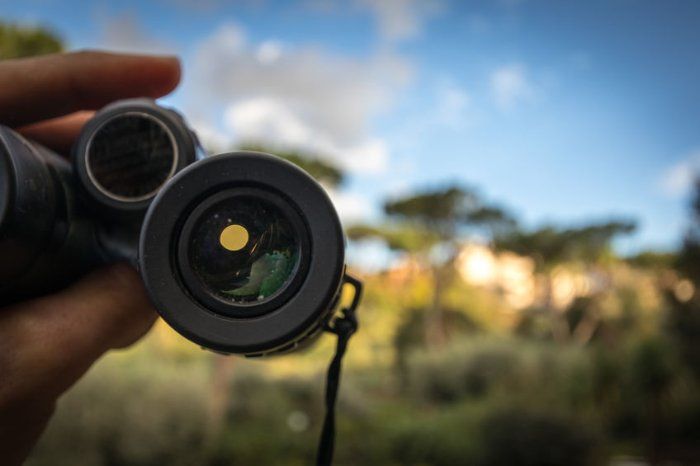
The whole purpose of buying binoculars is to see something better from far away.
It makes sense to wonder about a binocular’s range performance.
To truly understand what you will see with any pair of binoculars, you must understand the specs.
We’ll give you a rundown on how to make sense of the numbers, and by the end, you’ll see why asking how far you can see with binoculars is not the right question after all.
Binocular Specs & Range Performance
It’s natural to think in terms of distance and range when you want to see something that’s far away. The problem is binoculars don’t function to gain distance but instead to provide magnification.
What you really want to know is how much can I magnify an object, target, or a scene at a distance to clearly see what I want to see better?
Magnification
What do the numbers on binoculars mean?
The first number in a set of binocular specs will be the magnifying power it is capable of providing.
If it is 8x, what you will see will look eight times larger than what you see with the naked eye at the same distance, and so on.
Magnification preference is largely user dependent for some of the following reasons.
Low magnification:
- Easy to use
- Best suited to handheld use
- Wide fields of view
- Following moving targets
- Bow hunting
- Bird watching
- Event observation
If you prefer the benefits of having an even more compact optic that is fast to employ, covert, and can come with lower power and even competing magnification, consider a monocular.
High magnification:
- Much more detail observation on targets
- Can be tripod-mounted for steady use
- Large apertures can also provide good lowlight observation
- Can resolve details at greater distances
- Hunting
- Amateur astronomy
The bottom of it is higher magnification can help to resolve faraway targets. But there are also downsides to both low and high-powered binoculars.
Can you have too much power?
Yes. Consequences of too much magnification can result in:
- Narrow field of view
- Tunneling
- Unstable seeing due to vibrations
- Harder to use
- Optical assembly and quality that can’t actually provide the high power
If you want higher magnification to potentially acquire better seeing at longer distances, consider a spotting scope or check out how binoculars VS spotters stack up against each other.
With everything optics related, one component affects another that affects another. Enter here, the objective lens size.
Objective Lens Size
The actual diameter of the objective lens is called the aperture.
We have a very thorough explanation on why objective lense size matters here, and even though it’s targeted to rifle scopes, the key information is relevant to binoculars too.
The objective lens is the first point of contact with light before it reaches your eyes. It doesn’t literally “gather” light like so many like to say. However, its size does either allow or restrict how much light can enter the optic which has a direct effect on the quality of what you will end up seeing.
In terms of the aperture being relevant to how much you can see or how far you can see is a complicated matter. Generally, the larger the aperture, the more distance you can gain if you combine it with high magnification.
As general guidelines, the following apertures are appropriate for:
- 25mm: close-range viewing, compact, can be high-powered, good for tourists, poor low-light performance.
- 40 & 42mm: all-purpose, can be lightweight and compact, medium to high power, good for hunters, bird watching, sightseeing, etc.
- 50mm and larger: excellent for low-light, designed for steady setups (like on a tripod), heavy, good for hunters and wildlife observers. Larger sizes are better for resolving power in astronomy.
Field of View (FOV)
It’s not always about distance. How much you can see within the distance you’re observing at is also important.
This is when FOV and AOV (Angle of View) becomes relevant. What is it? We get into the nitty gritty about field of view here.
As a rundown, most manufacturers provide the linear FOV measurement. It is customary to see the FOV expressed as a measurement in feet or meters measured against a fixed distance that is typically 1000 yards or 1000 meters. This means that you will see an X-feet-wide view when looking at 1000 yards.
- For example, an ultra-wide FOV of 410 feet at 1000 yards means you will see a 410-foot-wide view when looking 1000 yards away.
Depending on what you’re doing, you may not mind the narrow field of view that comes with a high-power binocular if it means you get to see a larger view of a faraway object. Other times, if you’re following fast, moving targets like birds, you’ll need that wide FOV regardless of distance that comes with a medium-powered binocular.
So How Far Can You See with Binoculars?

Getting real, there really is no limit to how far you can see. But how well you can resolve that faraway object is something different.
You can see the Andromeda Galaxy with the naked eye that is 2.537 million light years away although it will be fuzzy. Being able to resolve it and see more detail will take an optic with magnification. See the point?
However, it’s not helpful to say that you can see as far away as you want with any pair of binoculars. To provide some insight, let’s take a look at some binocular specs.
10x50
This is a great platform that is popular with Western and open plain hunters, wildlife observers, and stargazers. With 10x magnification and a larger aperture, you have excellent viewing capabilities for daytime and some low-light use.
If you’re looking 10 miles away with 10x magnification, you’ll see that target as if it appears one mile away. What can you resolve adequately one mile away? A lot, but perhaps not as much as you may want.
If you’re looking at a doe 100 yards away, she will appear as if she is 10 yards in front of you. Now that may be what you need if you want to see her batt her lashes.
20x80
With specs like these, the 20x80 binoculars are undoubtedly for amateur astronomy. At this point, you should also be considering the differences between a spotting scope and telescope. However, unlike a telescope, you can use these binoculars for terrestrial use, although they won’t be your compact, ready-to-go kind of pair.
With the high and huge 20x80 specs, they’re adequately made for mounting as they’ll be heavy. High glass quality is a must-have if you want actual resolvable quality at max range. On land, you’ll be able to make out quite a bit more with 20x.
Take that 10-mile example from the 10x50 binoculars. That target will now appear to be half a mile away. Obviously, close-range observation will be overkill, as a 100-yard target will appear as if it’s five yards away. If it’s a large target, it may be difficult to make out what you’re looking at being so close up, but for spotting groups at the range, it may be perfect.
7x50
How far can you see with 7x50 binoculars?
Apparently, you can see beyond 3 million light years away. Although unassuming, these specs are good for amateur astronomy while they’re also good for treestand hunters, those in the woods, and really as an all-round performer for most applications.
They will actually provide better lowlight performance than the 10x50 due to the larger exit pupil, and they should be somewhat easier to handle freehand thanks to the lower power.
What else makes these great all-purpose binoculars is its wider field of view. It allows you to see more through the binoculars to orient yourself with the sky, to follow birds, or to stalk game.
8x42
When you think bigger is better, the humble 8x42 will bust that myth. It’s somewhat easier to handle than the 10x, has a much wider field of view, and tends to provide better eye relief with a larger exit pupil to stay out a little longer.
In fact, we put the 8x42 up against the 10x42 just to highlight its strengths. Popular with birders, bow hunters, treestand hunters, sightseers, and more, the 8x42 offers good clarity for both close and long ranges.
FAQs
Binoculars don’t have a distance limit on seeing just as your eyes don’t, but magnification has a lot to do with how much closer you can see a faraway object. The simplest answer is that a high-powered binocular will allow you to resolve more clearly at further distances.
Other features including glass quality and objective lens size will be relevant to know. Plus, equipment or additional features will be needed to achieve clarity at maximum distances such as image stabilizing or tripods.
High magnification binoculars are the most powerful binoculars you can buy. These will be in the 20x80 range, but there are some with 100mm objective lenses and even higher power of 90x magnification. The strongest pairs will be expensive as they must have quality behind them to support the optical demands of such an assembly.
There are several factors involved with getting good clarity at max distance with binoculars. There may not be enough magnification, it could be lacking in glass quality and/or coatings for optimal clarity, or you may simply need to calibrate and adjust the binoculars.
If you’ve correctly made user adjustments to your binoculars and are seeing blurred views at maximum distances, there are a number of reasons for this. There are just some things out of your control that optics cannot compete with. Atmospheric conditions, pollution, light pollution, and mirage can render even the best optics useless.
How Well Can You Resolve Objects at Max Distance?
Now that’s a question that’s closer to making sense. Binoculars provide magnification to allow for closer observation of something in the distance.
However, how well it can resolve is not up to magnification alone. There are many other factors involved that may just come down to glass quality. You pay more for better glass to acquire both resolving power and performance even if it means compromising on magnification.
How far can you see with the naked eyes? Infinitely far.
How far can you see with binoculars? Infinitely far with better resolving power.
Further Reading






